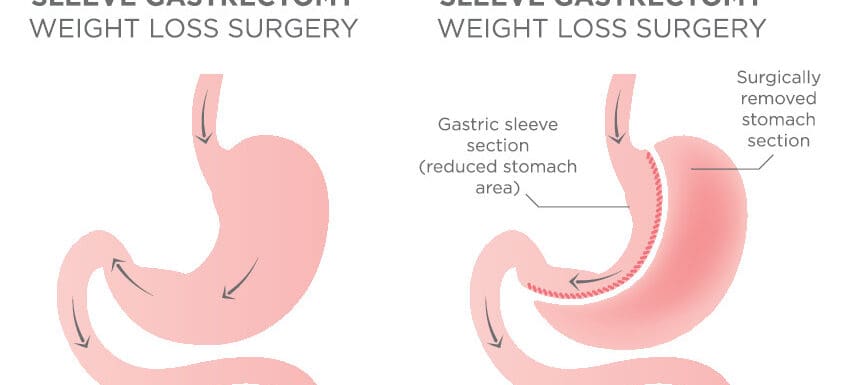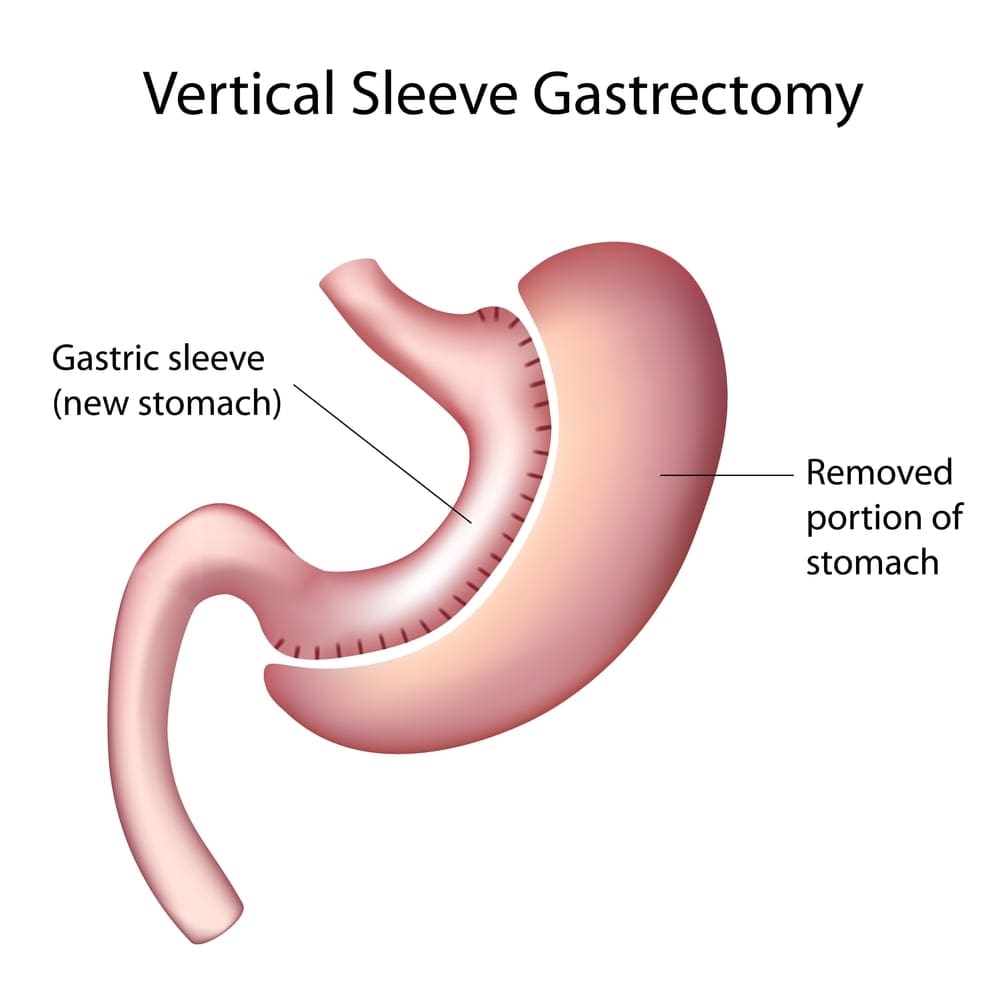Gastric Sleeve Pros and Cons Discussed by a Weight Loss Surgeon
Gastric sleeve pros and cons are something that I discuss with patients nearly every day as the Medical Director of JourneyLite. It’s a part of helping the patient figure out which operation is best for them. As an experienced gastric sleeve surgeon, I have several thousand of these procedures under my belt. So, I believe that writing about the pros and cons of gastric sleeve surgery could be helpful to patients everywhere.
No matter what surgeon you see for a consultation, the more informed you are the easier the process will be for both of you. Let’s begin.
What is Gastric Sleeve (VSG) Surgery?
Gastric sleeve surgery (also known as VSG) is a surgical weight loss procedure that helps patients lose weight by making the stomach smaller. This is accomplished by removing the side part of the stomach. This leaves behind a long narrow tube sort of like the sleeve on a jacket. Since around 80% of the stomach is removed, this will reduce its capacity to around one cup. Nothing is done to the small intestine downstream, so this helps to reduce the risk as compared to gastric bypass.
Why Gastric Sleeve Surgery is Popular
Lower risk, combined with good results, has made this the most popular weight loss surgery in the US. The operation is done with a few quarter-inch or half-inch incisions and a camera. So at JourneyLite, patients are usually able to go home the same day. This is called “laparoscopic surgery” and in my opinion is the best technique for these procedures. Robotic surgery has not been shown to reduce risk of gastric sleeve surgery, and increases procedure time and cost significantly.
After a VSG, a patient will get full on much, much smaller portions than prior to surgery. Also, hunger will usually be reduced, especially for the first several months. Therefore, a patient will lose weight because they are overall less hungry, and they eat less! But the operation is not magic–a healthy lifestyle must be adopted. Patients must commit to maintaining a low-carb, high-protein diet and a regular exercise regimen to keep the weight of long-term. This applies universally, whether you are considering gastric sleeve pros and cons or gastric bypass pros and cons!
Advantages of Gastric Sleeve Surgery
As with any weight loss surgery, there will be some advantages and disadvantages. I have seen thousands of patients who have had both VSG and RNY over the last 20 years, so I have a pretty good feel for both. Let’s first take a look at the advantages!
Unlike in a gastric bypass, we do absolutely nothing to the small intestine. This has pros and cons which I’ll discuss below.
- Gastric sleeve surgery is much simpler and less-invasive than gastric bypass. So short-term risks are lower. In surgical procedures, we define short-term as the first 30 days after surgery.
- Since no intestine is bypassed, the long-term risk of a VSG is also much lower than for gastric bypass. The lack of bypassed intestine reduces the risk of:
- vitamin and nutrient deficiencies
- anemia
- hypoglycemia (low blood sugar)
- dumping syndrome
- small bowel obstructions
- marginal ulcers
- internal hernias
- Weight loss is more rapid with a gastric sleeve than for a Lap Band. In my experience the rate is fairly similar to what we see with gastric bypass. This can help the patient remain motivated and stay on track.
- Minimal long-term maintenance is required with a VSG as compared to both gastric bypass and Lap Band. When I see a sleeve patient in the office, I don’t have to worry about sticking a needle into a patient to adjust their Lap Band, and I typically don’t see bypass-related issues like iron deficiency that need to be addressed.
- Quality of life after a gastric sleeve improves rapidly. As the weight is usually coming off fast, I see patients who are finding an almost immediate reduction in joint pain, blood pressure and sleep apnea symptoms. Likewise, there is an immediate increase in mobility and improved social interactions.
I once had a patient who had sleep apnea that was so severe he had to have a tracheostomy. He could barely even walk. When he came in for his 1 year post-op visit, not only had his tracheostomy been long-removed, but he rode his bicycle to his appointment! This is just one example of the many ways I see weight loss surgery transform patients’ lives.
In my years as a weight loss surgeon, I have seen gastric bypass patients present with these complications even 20 years out from their initial procedure.
Disadvantages of Gastric Sleeve Surgery
The disadvantages of gastric sleeve surgery are few, but there are some.
- The risk of GERD that cannot be controlled with medication is higher with gastric sleeve surgery than gastric bypass. This can, in some cases, require an additional surgical procedure to correct.
- The advantages of not involving the small intestine are outlined above. This comes with a disadvantage as well though. Bypassed small intestine gives gastric bypass surgery an additional level of power and somewhat better long-term weight loss results.
- Although the remission rate for type 2 diabetes is excellent for gastric sleeve, it’s even better for gastric bypass.
- While not necessarily a “disadvantage” but more of a surgical risk, there is a possibility of short-term complications such as bleeding and staple line leaks after a gastric sleeve. These risks also apply to gastric bypass surgery.
Gastric Sleeve Pros and Cons FAQs
What happens 10 years after a gastric sleeve?
Ten years post-gastric sleeve surgery, patients often experience significant weight loss, with studies indicating that they can achieve roughly 50% excess body weight loss, similar to the results seen with gastric bypass surgery. However, it’s crucial to note that the long-term success of any weight loss surgery depends not only on the type of operation but also on the patient’s commitment to lifestyle changes and healthy habits.
Can you have a normal life after a gastric sleeve?
With the weight loss achieved by most patients after a sleeve, life is not only normal but better! Here’s how:
Improved Health: With rapid weight loss and reduced risks of conditions like joint pain, high blood pressure, and sleep apnea, patients often experience a significant improvement in their overall health. This means fewer health complications and a higher quality of life.
Enhanced Mobility: Shedding excess weight can greatly enhance mobility, making physical activities and daily tasks easier and more enjoyable. Patients may find themselves able to participate in activities they couldn’t before, leading to a more active and fulfilling lifestyle.
Better Social Interactions: As self-confidence grows with weight loss, individuals often feel more comfortable and confident in social situations. This can lead to improved relationships, increased participation in social activities, and a more fulfilling social life overall.
Reduced Health Maintenance: Unlike some other weight loss procedures like gastric bypass or Lap Band, gastric sleeve surgery typically requires minimal long-term maintenance. This means fewer follow-up appointments, fewer adjustments or interventions, and less time spent on managing post-surgery issues, allowing patients to focus more on enjoying their lives.
Are there foods that I will never be able to eat again after a VSG?
There are restrictions in the short run, allowing time for the new anatomy to completely heal. In the long run, though, there are no foods that you are forbidden from eating. Our team of licensed/registered dietitians will make sure you know the food types that are optimal but there are times when you are allowed to splurge.
Are there any activities that I will no longer be able to do after a sleeve?
No. After you fully heal, which takes about 4 weeks, there is no restriction on any activities. Strenuous exercise, skydiving, scuba diving–all allowed and encouraged. As long as you follow your surgeon’s post-operative instructions, listen to your body, and prioritize your health and well-being, there’s no reason why you can’t participate in a wide range of activities and adventures after surgery.
How do you pull this large segment of stomach out through such a small incision?
We use an endoscopic pouch that is made of a substance similar to military-made parachutes! We place the excised piece of stomach into the pouch and pull it up through one of the incisions. We are able then to grasp one of the ends of the stomach and pull a little bit out. If it’s filled with fluid, we can insert a long, narrow suction device into it and remove the fluid. Once it’s empty it usually comes out pretty easily with gentle traction.






